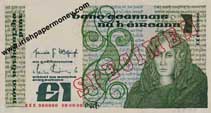
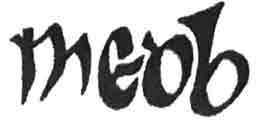
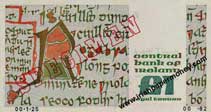
The Central Bank of Ireland Archive, which was opened to public access in 2017, has provided new source material on the designs of the Irish Series B banknotes. Some of the content of this article draws on information from the archive. This is referenced as CBIAR in the text.
The theme of the Series B Irish pound note is pre-Christian Irish mythology. The overall theme of Series B banknotes is that of Irish Writers, Philosophers and Artists. All of the banknotes also had a deliberate Celtic Irishness to their design which included being printed solely in the Irish language on the face of the notes, with English text on the reverse.
Ireland's Series B banknotes are sometimes referred to as the 'Celtic Design Series' or the 'Irish Punt Series', due in part to the design of the £1 and £5 denominations which had a significantly Celtic feel to them.
The new Medb Irish One Pound note entered circulation on 24 October 1977, three months after its first date of issue. It was the second denomination of the new Series B Irish bank notes to enter circulation.
Because of some problems with the design and the density of the ink on the face of the new Irish pound note, design development had fallen behind schedule. This resulted in the £5 note being issued ahead of the £1 note as the first denomination of the new Irish bank notes to enter circulation [1. CBIAR].
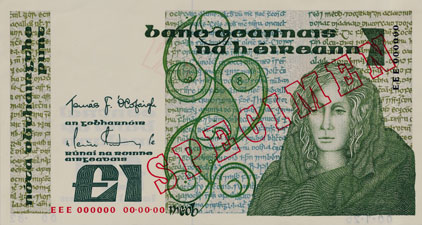
![]()
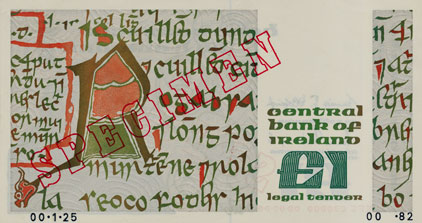
The typeface used on the face and reverse of the Medb pound note is one designed in 1953 by Michael Biggs of the Servicon team. It is a modern typeface based on Unical, and suits the overall Celtic design of the Irish pound notes.
On the face of the Medb Pound note is the text in Irish 'Banc Ceannais na h-Éireann' (Central Bank of Ireland) 'Nóta dlíthairgthe punt' (Legal tender note one pound). Additionally, below the signatures are the titles of the signatories in Irish: 'an gobharnóir' (governor) and 'rúnaí na roinne airgeadais' (secretary of the department of finance).
On the right is a prominent portrait of Queen Medb (Queen Maeve in English), legendary queen of Connaught, and daughter of the high king of Ireland.
Queen Medb features in the 'Ulster Cycle' [2.], a group of legends and tales set in the 1st century BC about the Ulaids, a people of northeast Ireland.
The stories were transmitted orally for centuries before they were written down between the 8th and 11th century. The earliest versions are in Lebor na hUidhre (The Book of the Dun Cow), written ca1100 and the earliest-known Irish language manuscript in existence, now in the Royal Irish Academy in Dublin, and in The Book of Leinster, written ca1160, now in Trinity College Dublin.
Queen Medb is the central protagonist in the Táin Bó Cuailnge (Cattle Raid of Cooley) [3.], legends from Irish literature of the 7th and 8th centuries.
The symbol in the centre of the face of the Maeve One Pound note is an early Irish design, which is based on a design found on bone slips which date back to the last centuries BC.
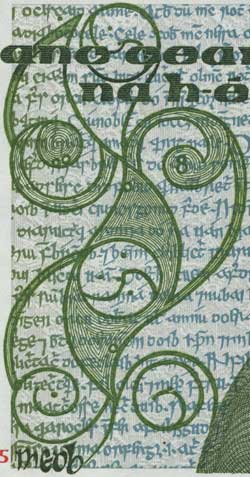
The Symbol in the centre of the Queen Medb One Pound note, Series B
The background design covering the entire face of the Irish £1 note is based on excerpts from Lebor na hUidhre [4.], written almost entirely in Irish, and one of the earliest-known Irish language manuscripts in existence [5.]. The book is held in the Royal Irish Academy.
On the reverse of the Medb Irish One Pound note is a decorated excerpt of the Táin Bó Cuailnge from Lebor na hUidhre, which is the earliest known surviving manuscript containing it.
The main text on the reverse of the Irish one pound note is printed entirely in English, the text 'Central Bank of Ireland Legal Tender' being the only type.
The actual page of Lebor na hUidhre which was used as a basis for the design of the reverse of the Queen Medb pound note is identified as MS. 23 E 25, p.77 in the Royal Irish Academy. The entire work of the can be viewed in high resolution on the CODECS website [6.].
The reverse design of the banknote is quite faithful to the intricate original ancient manuscript. However, there are a few notable differences in design between the reverse of the Queen Medb banknote version and the original manuscript.
There is an extra word, la, added at the bottom left on banknote. Additionally, some lettering along the bottom of the extract is not reproduced on the banknote. On the left, a small portion of the lettering is omitted on the banknote, and the design is slightly rearranged around the area.
Above, p77 of Lebor na hUidhre, which is approximately 290 mm high, showing the area used as a basis for the banknote design. The white-out areas are not used on the banknote. The actual page can be viewed online at https://codecs.vanhamel.nl/Dublin,_Royal_Irish_Academy,_MS_23_E_25
Published by the A. G. van Hamel Foundation for Celtic Studies. Reproduced here under this licence: https://codecs.vanhamel.nl/Show:CODECS/Terms_of_use
The excerpt of the Táin Bó Cuailnge from p77 of Lebor na hUidhre used on the reverse design of the Queen Medb one pound note is compared with the reverse design of the banknote
Published by the A. G. van Hamel Foundation for Celtic Studies. Reproduced here under this licence: https://codecs.vanhamel.nl/Show:CODECS/Terms_of_use
When the size of the section of Lebor na hÚdire used on the reverse of the Irish one pound note is compared to an actual banknote, it can be seen that the detail is nearly twice as big on the note. The original stylised letter R is 31.5 mm tall. On the banknote it is 60 mm tall.
The Queen Medb Irish One Pound note was a radical design change from the old 'Lady Lavery' Irish One Pound note which it replaced. The Series A 'Lavery' design banknotes had been in circulation since 1928.
One Pound was the most common denomination note in circulation. The new Queen Medb pound note was a banknote that almost everyone would encounter immediately upon its release.
The Series B Irish £1 notes were marginally smaller in size than the Series A notes they replaced. Dimensions of Irish pound notes tended to vary by a millimetre or so in either dimension. The dimensions below are from measurements of actual notes.
Series A, Lady Lavery Pound Note, 151 x 84 mm.
Series B, Queen Medb Pound Note, 148 x 78 mm.
Below are illustrated the final date of Series A £1 notes, and the first date of Series B £1 notes.
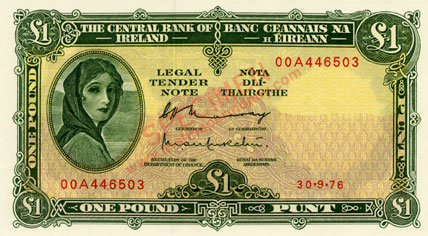
![]()
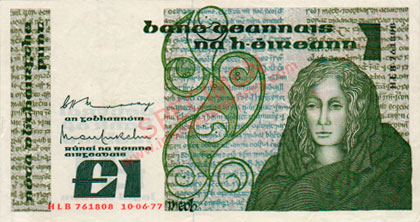
The Series B banknotes also became known as the 'Irish Punt series', more commonly abroad than in Ireland, due likely to their being printed entirely in Irish on the face. The Queen Medb 'One Punt' was the commonest of the denominations, and examples of the note are easy to obtain in UNC grade, especially the final date of issue.
In contrast to the criticism of the Series B Five Pound note, released in 1976, which had received a mixed reception, the new Irish One Pound note was generally liked by the public. Its release also very forcefully brought attention to the fact that the days of the old 'Lady Lavery' Series A banknotes were numbered.
Face, primarily green, with some blue underprint. Serial numbers are in red and black ink. All notes bear a date of issue in red ink, with each date being tied to a specific group of prefixes.
Reverse colouring is multicoloured, with mainly greens and reds.
Below is a cromalin proof in black ink of the green intaglio printing, along with an error note which is missing almost all of this second print. The error note shows clearly all the elements of the One Pound note's underprint, and reveals that the portrait of queen Medb was printed on top of the underprint rather than on an unprinted knock out area.
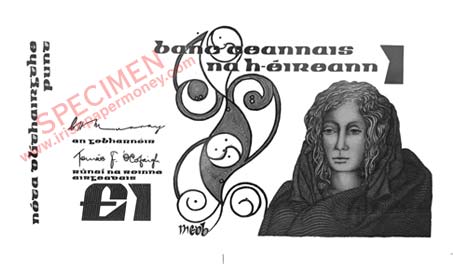
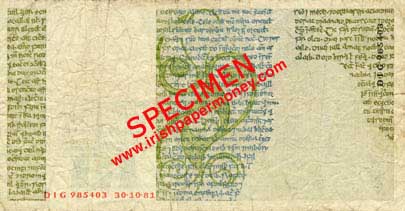
Metallic Thread: A metallic security thread is embedded in the paper slightly to the right of center when the note is viewed from the face side. This was a standard security feature used in Irish banknotes of the time.
Certain areas of the face and reverse of the Series B £1 note fluoresce under UV light. The areas exhibiting fluorescence on later Irish pound notes differ from those of earlier issues. The intensity of the fluorescence also varies.
UV flourescent features were being introduced to Irish bank notes as the Series B banknotes were developed.
It is possible that the Irish pound notes were used to test the effectiveness of certain aspects of UV features, or that less expensive UV features were used on the £1 note than on higher denominations.
UV activity is most prominent on the reverse of the one pound note.
The Queen Medb One Pound note was the second denomination of the new Series B banknotes to enter circulation. The note circulated for 13 years. The Irish pound note was withdrawn from circulation in June 1990, and replaced by a £1 coin, issued on 20 June 1990.
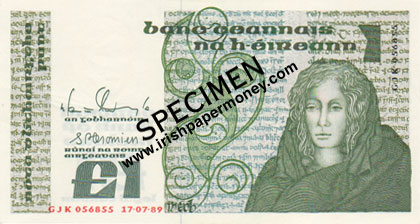
E136, Type 16. Signatures: C. H. Murray, M. O Murchú. 6 Dates, 4 replacements BBB, 1 base letter. 10.06.77-29.11.77.
E137, Type 17. Signatures: C. H. Murray, Tomás F. Ó Cofaigh. 23 Dates, 10 replacements, BBB, DDD, GGG, 3 Base letters. 30.08.78–30.10.81.
E138, Type 18. Signatures: Tomás F. Ó Cofaigh, Maurice Doyle. 29 dates, 12 replacements, GGG, BBB. 2 Base letters. 30.06.82-24.04.87.
E135, Type 19. Signatures: Maurice Doyle, S. P. Cromien. 9 Dates, 4 replacements, BBB, 1 base letter. 23.03.88-17.08.89.
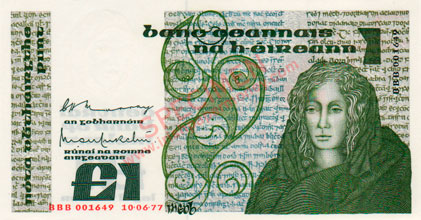
![]()

![]()

![]()
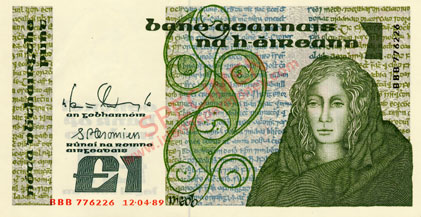
The four signature varieties of the Queen Medb Series B Central Bank of Ireland One Pound notes illustrating replacement note prefixes
There were 67 dates of issue for the Series B Irish pound note. The first date issued was 10.06.77, and the final date was 17.07.89.
The Queen Medb one pound notes are common, and it is quite feasible to collect all 67 dates of issue quite inexpensively. An image of each of the 67 dates of issue can be viewed on the Series B One Pound Note Dates page.
One Pound Queen Medb replacement notes used a prefix of three letters the same as identifiers, as did all Irish replacement notes of Series B and Series C. Throughout the lifetime of Series B, the Medb one pound notes used letters BBB, DDD, GGG, and BBB in that order.
BBB was used on Irish pound note dates from 10.6.77 through to 18.01.79. DDD was used from 11.07.79 to 21.05.81. This changed to GGG on dates from 09.10.81 to 22.04.87. The replacement note prefix then reverted to BBB on dates from 24.04.87 to 12.04.89.
Visit the Irish Replacement Notes List for up to date information on sightings of Queen Medb one pound replacement notes, as well as a full listing of serial number brackets for each replacement note date. An image of every recorded replacement note date can be viewed in the Series B View By Date page.
A further date might have been allocated to the £1 note denomination. 13.09.89 is mentioned on the Central Bank of Ireland website as being the final date of issue for the Queen Medb Pound note [7.].
However, an example of this date has never been seen for Irish pound notes. The final date recorded, 17.07.89, was printed with two complete prefix runs of 12 million notes each, making 24 million notes dated 17.07.89. This is twice the normal maximum number of notes per date for Series B Irish pound notes.
Irish £1 notes dated 17.07.89 were printed with prefixes AJK-LJK and AAK-LAK. AAK-LAK might originally have been allocated to 13.09.89. It also may be the case that a further printing of £1 notes dated 13.09.89 were printed and never issued. More research is needed on this to determine the nature of this September 1989 date.
References [Last retrieved 04.08.24]
1. Central Bank of Ireland Archives, Dublin. Referred to as CBIAR in the text. [Accessed 24 May 2018].
2. The Ulster Cycle <https://www.britannica.com/art/Ulster-cycle>
3. Táin Bó Cuailnge (Cattle Raid of Cooley) <https://www.britannica.com/topic/The-Cattle-Raid-of-Cooley>.
4. Lebor na hUidhre <https://www.isos.dias.ie/RIA/RIA_MS_23_E_25.html>
5. <https://codecs.vanhamel.nl/Dublin,_Royal_Irish_Academy,_MS_23_E_25>
6. Lebor na hUidhre, p77, held at the Royal Irish Academy. Image source: CODECS: online database and e-resources for Celtic studies, Online: Stichting A. G. van Hamel voor Keltische Studies. <https://codecs.vanhamel.nl/>
Published by the A. G. van Hamel Foundation for Celtic Studies. Reproduced here under licence: https://codecs.vanhamel.nl/Show:CODECS/Terms_of_use
Source: https://codecs.vanhamel.nl/Dublin,_Royal_Irish_Academy,_MS_23_E_25
To go to the page used for the reverse design of the Queen Medb £1 note scroll down on the right to p77.
7. <https://www.centralbank.ie/consumer-hub/notes-and-coins/historical-banknotes/1970s---1990s>
Background Reading
1. The Ulster Cycle <https://college.lclark.edu/live/blogs/68-once-upon-a-time-irish-mythology-crash-course>
1 Pound Ploughman
5 Pounds Ploughman
10 Pounds Ploughman
20 Pounds Ploughman
50 Pounds Ploughman
100 Pounds Ploughman
Irish Ten Shilling Notes
1 Pound Note Lady Lavery
5 Pounds Lady Lavery
10 Pounds Lady Lavery
20 Pounds Lady Lavery
50 Pounds Lady Lavery
100 Pounds Lady Lavery
1 Pound Note, Queen Medb
5 Pound Note, John Scotus Eriugena
10 Pound Note, Jonathan Swift
20 Pound Note, W. B. Yeats
50 Pound Note, Turlough O'Carolan
100 Pound Note, Grace O'Malley
5 Pound Note, Sister Catherine McAuley
10 Pound Note, James Joyce
20 Pound Note, Daniel O'Connell
50 Pound Note, Douglas Hyde
100 Pound Note, Charles Stewart Parnell
Northen Ireland Polymer notes
Bank of Ireland Polymer Notes
Danske Bank Polymer Notes
Ulster Bank Polymer Notes
Special Sections and Articles
The Transition of Irish Currency, Irish banknotes 1918–1928
The Partition of Irish Currency, Irish banknotes 1928–1930
Banknote Design Evolution 1824 to 1916
Irish Three Pound Notes
Contemporary Forgeries of Early Irish Banknotes, ca1800-1930
Limerick Soviet Notes
Irish World War 2 Banknote Issues
Low Number Irish Banknotes
Irish Joint Stock Banks of Note Issue from 1783
Irish Legal Tender Note Specimens
Ploughman Scan Survey (PSS)
![]() Stable Version. Revision pending with addition of images. Last update 23.08.24.
Stable Version. Revision pending with addition of images. Last update 23.08.24.